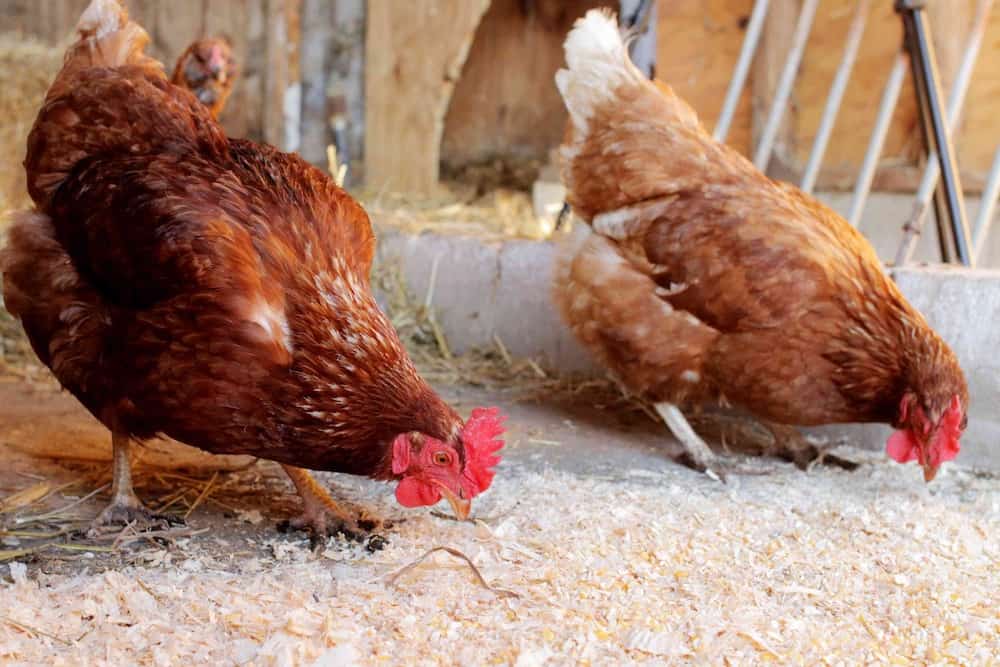Chickens, How To Do Things
What Do Chickens Need in a Coop: A Complete Guide
Are you interested in keeping chickens? If so, you’ve come to the right place! Whether you’re a seasoned chicken keeper or just starting out, understanding the specific needs of your feathered friends is essential.
Keeping backyard chickens can be an incredibly rewarding experience. Not only do they provide fresh eggs, but they also offer companionship and entertainment.
However, to ensure their health and happiness, it’s important to create a suitable living space for them.
From ventilation to adequate space and nesting areas, we’ll cover the important components you need to know about creating a comfortable home for your flock.
So let’s dive in and discover how to give your chickens the coop they deserve!
Free Range vs Enclosed Chickens
Free range and enclosed are two different ways to raise chickens. Each method of raising chickens has its own advantages and disadvantages, which should be considered when deciding how to house your hens.
Free Range Method
Free range chickens are allowed to roam freely outside. They have access to open areas where they can forage for food, scratch the ground and dust bath. The main advantage of free range chickens is that they have the opportunity to engage in natural behaviours.
They can peck at insects and plants, which provides them with additional nutrients and mental stimulation. Free range hens also tend to have stronger immune systems due to exposure to sunlight and fresh air.
However, there are some drawbacks to free ranging your chickens. Predators pose a significant risk as they may attack or kill the birds while they are outside the protected enclosure.
Your chickens may also wander into neighbouring properties or roads, causing potential damage or accidents.
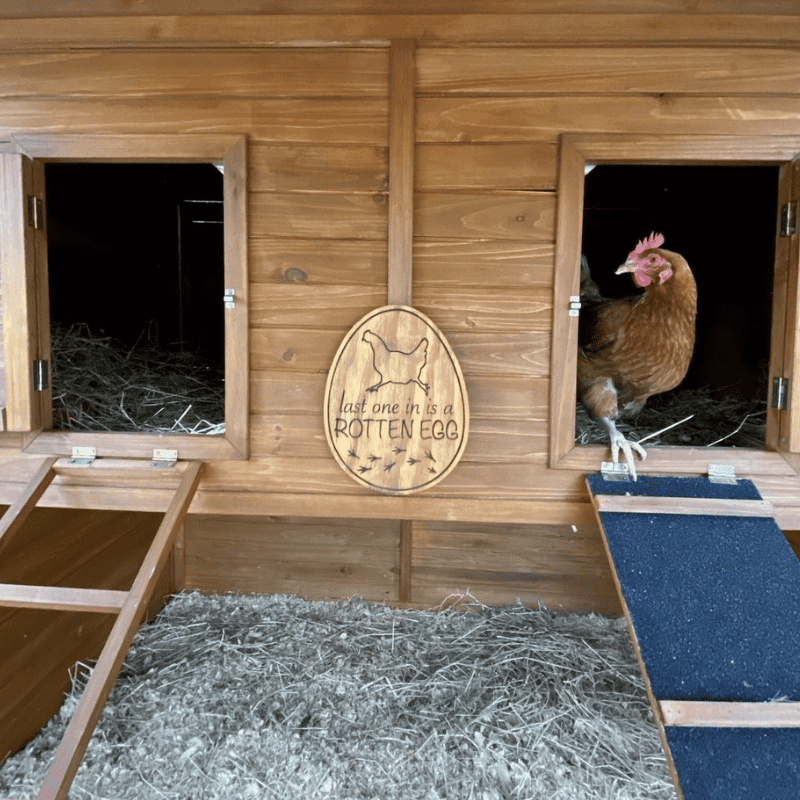
Enclosed Method
Enclosed chickens are kept within a confined area like a coop or run, where their movement is restricted. One advantage is increased protection from other animals. When housed in an enclosed coop or enclosed run behind strong chicken wire, chickens are less likely to be attacked by predators such as foxes or snakes.
Another advantage of keeping chickens in an enclosed space is better control over their diet. You can provide them with a balanced feed that meets all their nutritional needs without relying on foraging opportunities.
However, confinement can limit the natural behaviours of the birds. Chickens may not have as much space for exercise and exploration as they would in a free range environment. It’s important to provide enrichment activities and enough room for them to move around within the enclosed space.
Building The Perfect Chicken Coop
How Much Space Per Bird
When buying a chicken coop, it is important to provide personal space for your flock. Chickens need ample room to move around, stretch their wings, and engage in natural behaviours.
Insufficient space can lead to stress, feather picking, and health issues among your flock. To ensure that each chicken has extra space inside the coop, experts recommend allocating a minimum of 1 square metre per bird. This allows them to comfortably roost, nest, and walk around without feeling cramped.
The more space you give them, the happier they are!
How much space you need can vary depending on if you have larger breeds or if you plan on keeping chickens confined for extended periods due to weather conditions or predators.
In addition to the floor area, vertical height is equally important. Chickens love to roost and explore their surroundings from elevated positions. Aim for a minimum ceiling height of 80cm above ground level so that they can fully extend their wings without any hindrance.
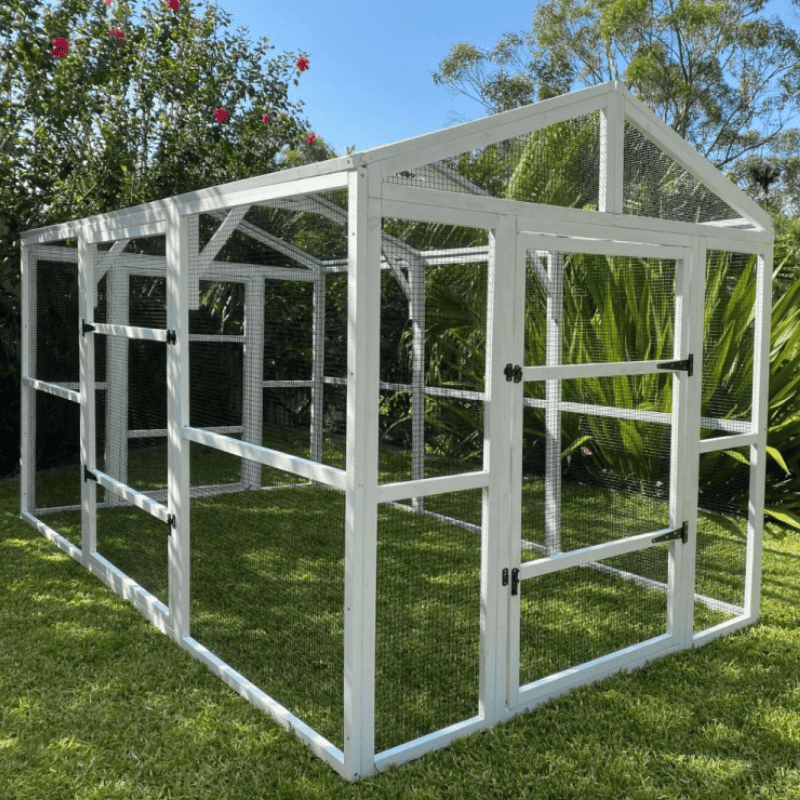
Floor Types
The type of flooring you select for your chicken coop plays a vital role in maintaining cleanliness and ensuring the well-being of your flock. Here are some popular options:
- Dirt: Many chicken coops simply have bare dirt as the floor surface. It allows chickens to exhibit their natural scratching behaviour while also providing them with dust-bathing opportunities. However, keep in mind that dirt floors may become muddy during rainy seasons.
- Concrete: Concrete provides excellent durability and makes cleaning easier since it doesn’t absorb moisture or odours like other materials do. It also prevents small animals from digging underneath the coop. To enhance comfort levels for your chickens’ feet, consider adding bedding material such as straw or wood shavings on top of the concrete surface.
- Wire Mesh: Wire mesh floors prevent predators from digging their way into the chicken coop. However, it’s crucial to provide a solid area within the coop where chickens can rest their feet comfortably and avoid any potential foot injuries from standing on wire all day.
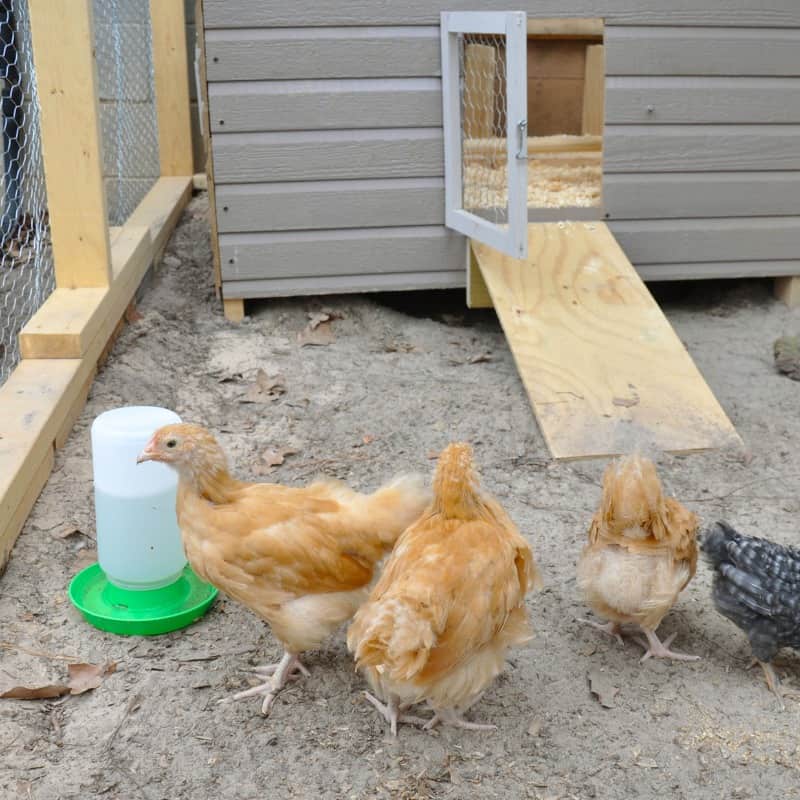
Ventilation and Insulation
Ventilation and insulation in the chicken coop contribute to the overall well-being of your flock.
The Significance of Good Ventilation in a Coop
Ventilation is vital for any chicken coop as it helps maintain air circulation, removes excess moisture, prevents the buildup of harmful gases, and minimises odours. Without adequate ventilation, the air quality inside the coop can rapidly deteriorate, leading to respiratory issues among your old hens.
To ensure proper airflow within the coop, strategically place vents on opposite sides of the structure. This allows for cross-ventilation, which facilitates the exchange of stale air with fresh air.
Installing adjustable vents enables you to regulate airflow based on seasonal requirements. Proper ventilation helps prevent condensation from accumulating within the coop. Excessive moisture can lead to damp bedding and promote bacterial growth, increasing the risk of diseases.
By allowing moist air to escape through vents or windows while keeping rain out with appropriate roofing materials, you can maintain a dry and hygienic environment for your feathered friends.
The Importance of Insulation to Regulate Temperature
Insulating your chicken coop is crucial for maintaining stable temperatures throughout different seasons.
Extreme temperature fluctuations can be detrimental to your flock’s health and egg production. Insulation acts as a barrier against external weather conditions by preventing excessive heat from entering during summer and retaining warmth during winter.
When insulating a new coop, focus on key areas such as walls, roof, and floor. Adding insulation material between walls helps trap heat or coolness inside while blocking outside temperature extremes from affecting the interior.
Insulating the roof prevents heat from radiating down during hot days and minimises heat loss in colder climates. Insulation materials such as foam boards, reflective barriers, or natural options like straw bales can be used effectively.
Ensure that the chosen insulation material is safe for chickens and doesn’t pose any health risks.
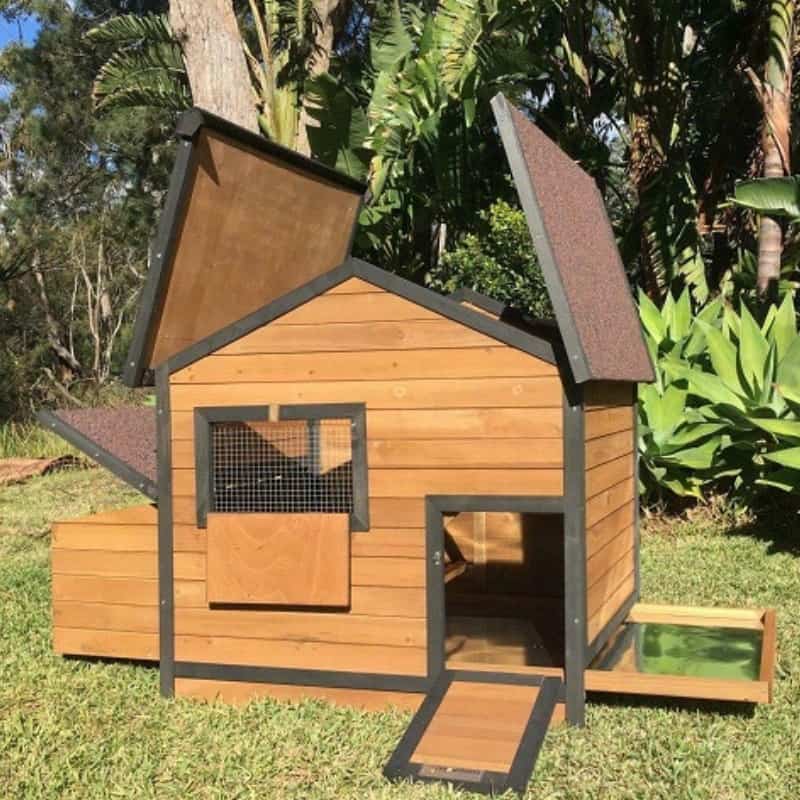
Nesting Boxes and Perches
By including nest boxes and perches in your chicken coop design, you create an environment that caters to their natural instincts and promotes overall well-being.
How Many Nesting Boxes are Required per Chicken?
Nesting boxes play a crucial role. These cosy compartments serve as private havens where hens can lay their eggs in peace. But just how many nesting boxes do you need per bird?
The general rule of thumb is to have one nest box for every three hens. You do not need one nesting box per hen as they will share and won’t all lay their eggs at once.
However, keep in mind that some factors may influence this ratio. If you have particularly broody or dominant hens, it might be beneficial to increase the number of nest boxes available.
If you notice any signs of aggression or egg-eating behaviour among your flock, providing more nesting boxes could help alleviate these issues.
Creating an inviting environment with ample nest boxes not only promotes good egg-laying habits but also minimises stress among your feathered friends.
Remember to position the nest boxes at a height that’s easily accessible for your chickens and ensure they are well-ventilated and kept clean.
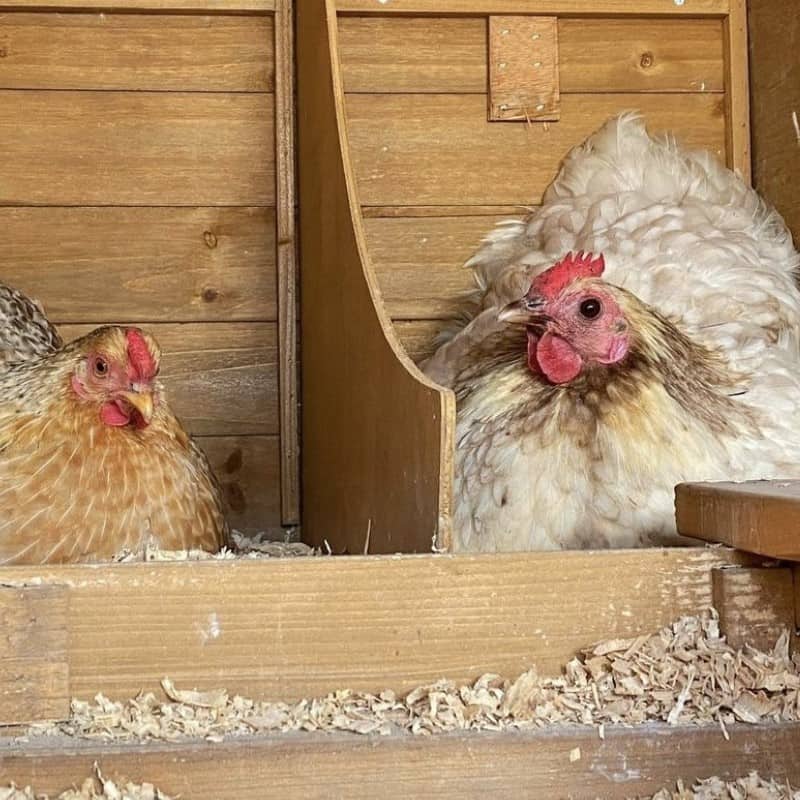
Exploring the Role of Perches in Chicken Behaviour and Well-being
Chickens naturally seek higher ground when it comes time to sleep or rest, as it provides them with a sense of security from potential predators on the ground.
By incorporating perches into their coop design, you create an environment that allows them to exhibit this instinctual behaviour.
In addition to promoting better sleep patterns, perches also help maintain foot health by allowing chickens’ feet to stretch out fully while roosting. This helps prevent bumblefoot—a painful infection that can occur when pressure is consistently placed on the feet.
When installing a roosting bar, ensure they are sturdy and large enough for your birds to perch comfortably. The ideal diameter for a perch with rounded edges is around 5cm, as this allows chickens to grip it securely without straining their feet.
Consider providing different heights and levels within the coop to depending on what your hens prefer.
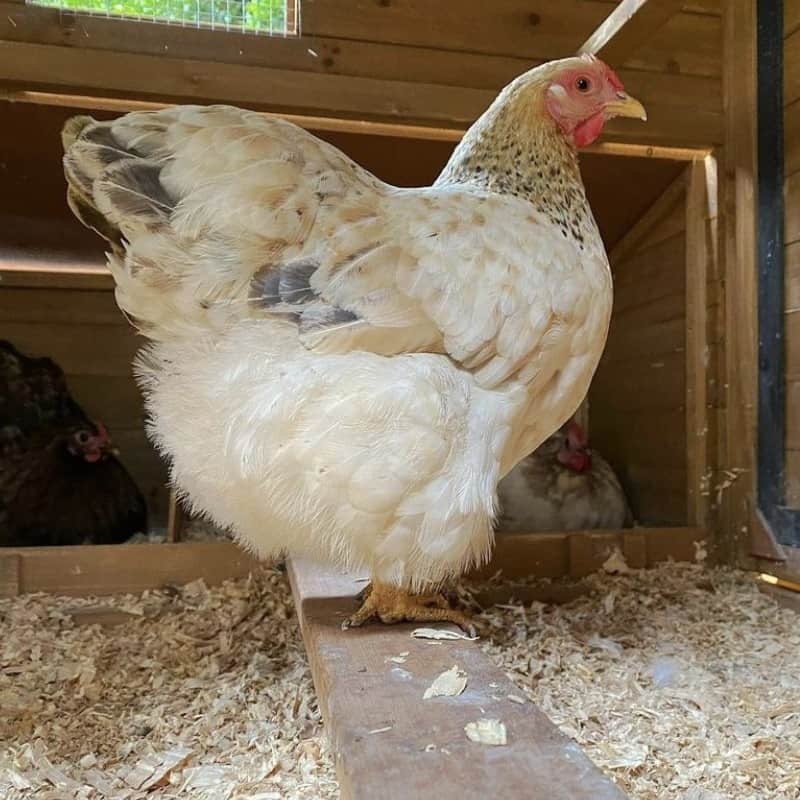
Feeder and Drinker Types
The right types of feeders and drinkers not only ensure that your chickens have access to food and water but also help maintain cleanliness in the coop.
Different Types of Feeders Suitable for a Chicken Coop
- Trough Feeders: These are long, open containers that allow multiple chickens to eat at once. Trough feeders are suitable for larger flocks as they provide ample space for feeding. They are easy to refill but also allow easy access for mice and rats.
- Bell Feeders: Bell-shaped feeders have a moat around the base where your flock are able to access their feed. This stops the chickens from being able to jump into their food and make a mess. Bell feeders can be hung from the roof to stop chickens knocking them over.
- Automatic Feeders: If you’re looking to save wasted feed, automatic feeders are a great option. When chickens step up onto the treadle, the lid opens and allows them access to their food. This prevents mice, rats and native birds from accessing the feed.
Different Types of Drinkers Suitable for a Chicken Coop
- Open Water Containers: Simple yet effective, open water containers can be placed on the floor of the coop or elevated slightly using bricks or blocks. Chickens can easily drink from these containers, which should be cleaned regularly to prevent contamination.
- Nipple Drinkers: Nipple drinkers consist of small valves that release water when pecked by chickens. These drinkers minimise wastage and keep the water clean since they prevent dirt and debris from entering the container.
- Bell Drinkers: Bell-shaped drinkers are very similar to bell feeders except they hold water instead of feed. They are the most popular option for backyard chickens as they are very easy for owners to clean and refill.
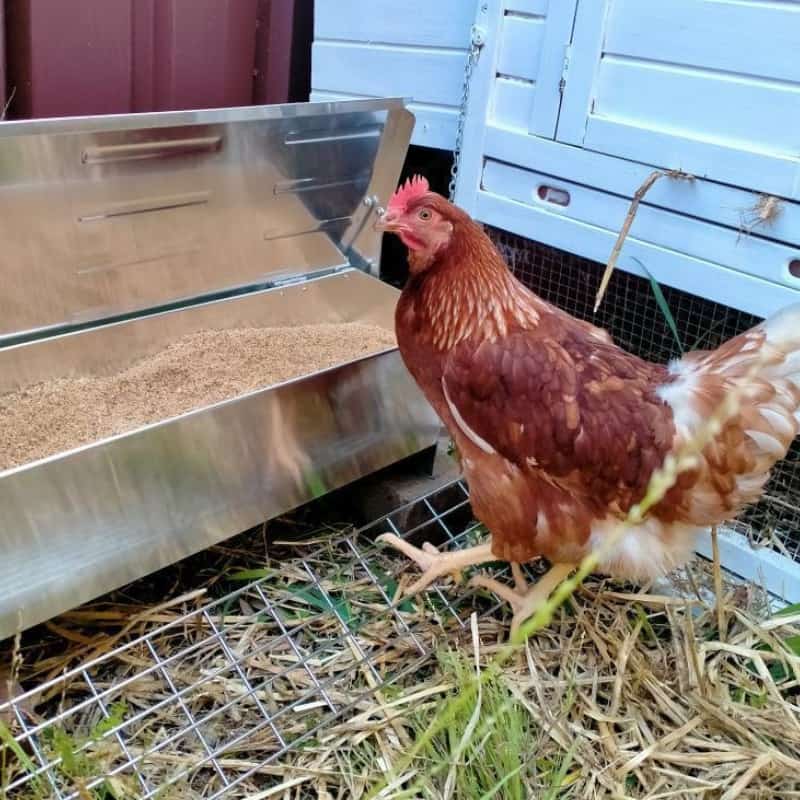
Providing Ample Space for Exercise and Roaming
It is important to provide space for your feathered friends to exercise and roam freely. Chickens need sufficient room to stretch their wings, explore their surroundings, and engage in natural behaviours.
Allowing Sufficient Space Outside the Coop for Exercise
Chickens are naturally active animals that require plenty of room to move around. By allowing them access to a spacious outdoor area, you provide them with opportunities for physical activity and mental stimulation.
A backyard or garden can serve as an ideal space for chickens to explore, scratch the ground, and peck at insects. This not only keeps them entertained but also helps maintain their overall health.
To ensure chickens have enough space outdoors, consider installing chicken wire or hardware cloth fencing around the designated area. This will prevent them from wandering off too far while still granting them freedom to roam within safe boundaries.
Having a secure enclosure protects your chickens from predator attacks and ensures their safety.
Benefits of Allowing Chickens to Roam Freely
Allowing chickens to roam freely has numerous advantages. Firstly, it allows them to engage in natural behaviours such as dust bathing and foraging for food.
Chickens prefer access to a larger area – they can find insects and plants that contribute essential nutrients to their diet.
Moreover, free-ranging chickens tend to be happier and less stressed compared to those confined in smaller spaces.
They have more opportunities for social interaction with other members of the flock and can establish pecking orders without feeling overcrowded or restricted.
Promoting Physical Activity to Maintain Healthy Chickens
Just like humans, chickens need regular exercise to stay fit and healthy. Providing ample space encourages physical activity among your flock members by allowing them room for running, stretching their wings, and engaging in playful behaviour.
Regular exercise helps maintain good muscle tone, strengthens bones, and promotes overall well-being.
To further promote physical activity within the coop itself, ensure that the interior is spacious enough for chickens to move around comfortably.
Consider your flock size when planning the dimensions of your first chicken coop. Providing adequate floor space allows them to walk and run freely without feeling cramped or restricted.
In addition to providing enough space, you can enhance their exercise routine by incorporating different structures and features within the coop, such as ramps or branches.
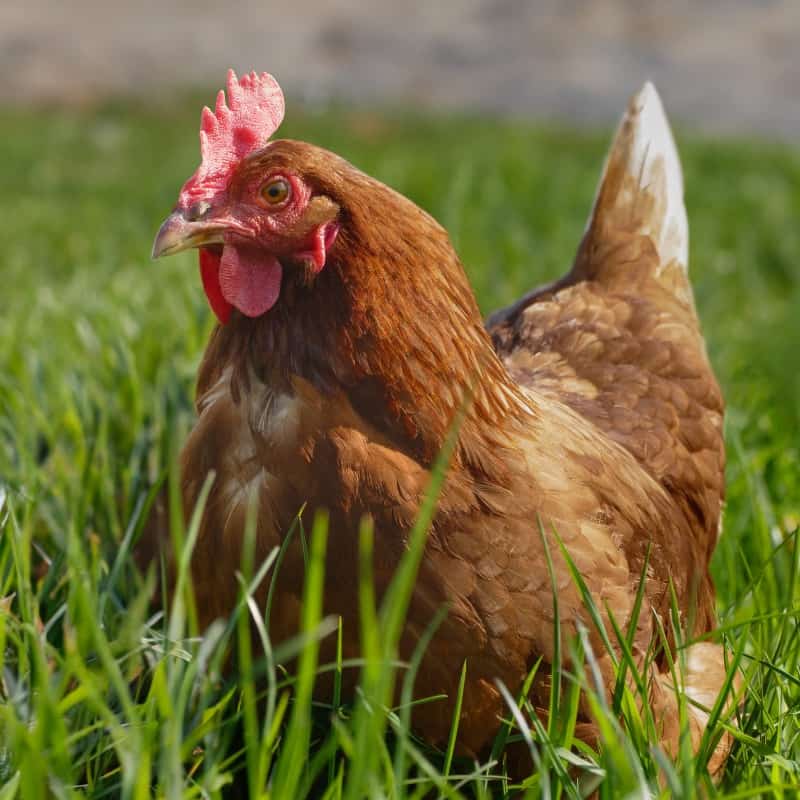
Jordan’s Wrap
Taking care of chickens and providing them with a chicken coop is essential for their health and happiness. Whether you choose free range or enclosed housing, remember to give them enough space, clean bedding, good food and water, and proper ventilation.
By doing so, you’ll have happy and healthy feathered friends who will reward you with fresh eggs and lots of joy!
FAQs
How Often Should I Clean My Chicken Coop?
Regularly cleaning the chicken coop is crucial to maintain a healthy living environment for your chickens. It is recommended the chicken coop is cleaned weekly as a bare minimum.
Remove soiled bedding material, replace it with fresh bedding, scrub surfaces if necessary, and disinfect regularly.
What Kind Of Bedding Material Should I Use In The Nesting Boxes?
Straw or pine shavings are commonly used as bedding materials in nesting boxes. These materials provide a soft and comfortable surface for the chickens to lay eggs.
Read our Best Bedding for Coops Guide
Can I Keep Different Chicken Breeds Together In One Coop?
Yes, you can keep different chicken breeds together in one coop. However, it’s important to consider the size and temperament of each breed to avoid conflicts or overcrowding.
Provide ample space for each breed to comfortably coexist and monitor their interactions closely to ensure harmony.



